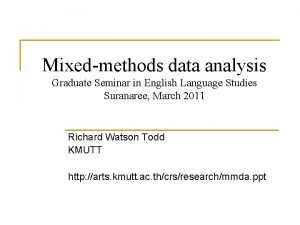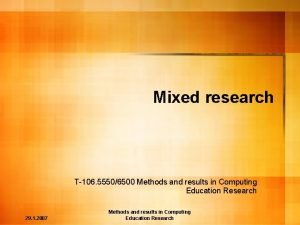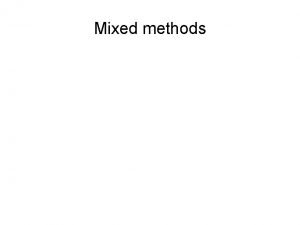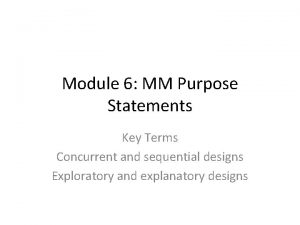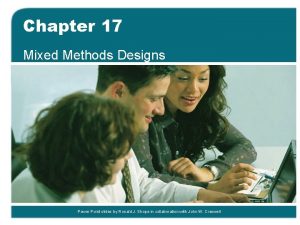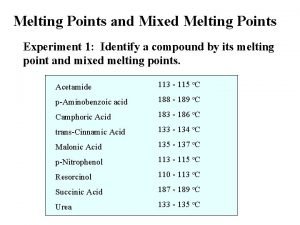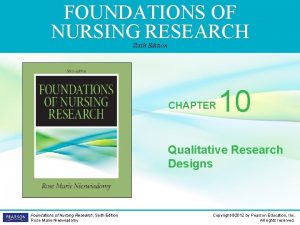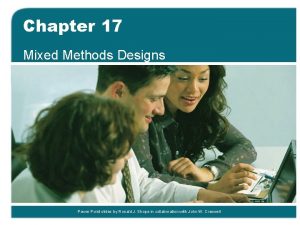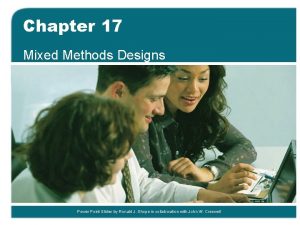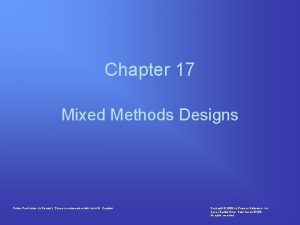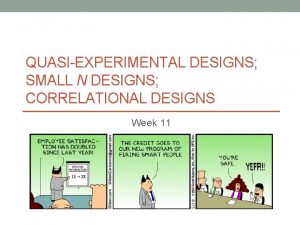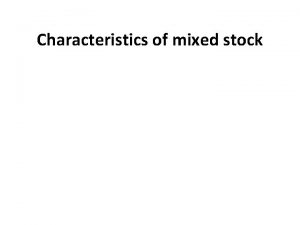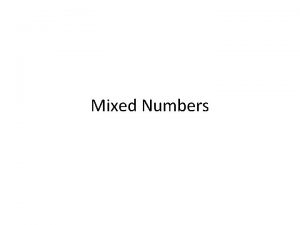Chapter 17 Mixed Methods Designs Power Point slides




















- Slides: 20

Chapter 17 Mixed Methods Designs Power Point slides by Ronald J. Shope in collaboration with John W. Creswell

Key Ideas • • • Defining mixed methods research When do you use mixed methods designs? The development of mixed methods research Types of mixed methods designs Key characteristics of mixed methods research • Steps in conducting a mixed methods study • Evaluating a mixed methods study Educational Research 2 e: Creswell

What is mixed methods research? A mixed methods research design is a procedure for collecting, analyzing, and “mixing” both quantitative and qualitative data in a single study to understand a research problem. Educational Research 2 e: Creswell

When do you use mixed methods research? • When both quantitative and qualitative data, together, provide a better understanding of your research problem than either type by itself • To provide a complete picture of the research problem – Quantitative: trends and describing population – Qualitative: participants’ words • When you want to build from one phase of a study to another – Explore qualitatively then develop an instrument – Follow-up a quantitative study to obtain more detailed information. Educational Research 2 e: Creswell

How did mixed methods research develop? • Mixing of forms of quantitative data – Campbell and Fiske (1959) Multitrait Multimethod approach) – Developing multiple psychologial traits using multiple methods • Expanding into triangulation of quantitative and qualitative (Jick 1979 merger study) • Debating the integration of worldviews and methods • Developing procedures for designs • Advocating for a distinct design (Greene & Caracelli, 1997; Tashakkori & Teddlie, 1998) Educational Research 2 e: Creswell

Identifying a mixed methods study in the literature • The title for words such as “mixed methods” or “multi-method” etc. • Data collection section indicates both qualitative and quantitative data were collected • Purpose statement and or research questions indicate that the researcher intends to collect both quantitative and qualitative data during the study Educational Research 2 e: Creswell

Identifying a mixed methods study in the literature • Priority or weight: qualitative, or quantitative or both equally • Sequence of collecting quantitative and qualitative data is indicated • Analyze both data sets – Combined in one analysis (Integrated) – Separate analysis Educational Research 2 e: Creswell

A notation system for designs Study #1 QUAL + QUAN + indicates the simultaneous or concurrent collection of quantitative and qualitative data. Study #2 QUAN qual Shows sequential collection of quantitative and qualitative data NOTATION USED Uppercase letters indicate a priority or increased weight for either quantitative and qualitative data. Lowercase letters indicate a lower priority or weight for either quantitative or qualitative data Educational Research 2 e: Creswell

Mixed methods designs: Explanatory design • Researcher places priority on quantitative (QUAN) data collection and analysis • Researcher collects quantitative data first in the sequence • Researcher uses the qualitative data to refine the results of the quantitative data Educational Research 2 e: Creswell

Mixed methods designs: Triangulation design • Researcher gives priority to both quantitative (QUAN) and qualitative (QUAL) data • Researcher collects both quantitative and qualitative data simultaneously • Researcher compares the results from quantitative and qualitative analysis to determine if the two data bases yield similar or dissimilar results Educational Research 2 e: Creswell

Mixed methods designs: Exploratory design • Research emphasizes qualitative (QUAL) data rather than quantitative (quan) data • Researcher has a sequence to data collection that involves collecting qualitative data followed by quantitative data • Researcher plans on the quantitative data to build on or explain the initial qualitative findings Educational Research 2 e: Creswell

Types of mixed methods designs I. Triangulation mixed methods Design QUAN Data and Results + Interpretation QUAL Data and Results II. Explanatory mixed methods Design QUAN Data and Results Follow-up qual Data and Results III. Exploratory mixed methods Design QUAL Data and Results Building Educational Research 2 e: Creswell quan Data and Results

Key Characteristics of mixed methods Design • Rationale for the design • Collecting quantitative and qualitative data • Priority • Sequence • Data analysis matched to design • Diagram of the procedures Educational Research 2 e: Creswell

Key characteristics of mixed methods designs: Rationale • Rationale – Test findings of first phase – Explain in more detail results of first phase – Provide a more complete understanding than either quantitative or qualitative alone • Collecting both qualitative and quantitative data – Numeric data – Text data Educational Research 2 e: Creswell

Key characteristics of mixed methods designs: Rationale • Priority – Equal weight – Quan carries more weight than qual – Qual carries more weight than quan • Sequence – Collect both quantitative and qualitative data at the same time. – Collect quantitative data first, followed by qualitative data. – Collect qualitative data first followed by quantitative data. Educational Research 2 e: Creswell

Key characteristics of mixed methods designs: Rationale • Analysis matched to design – Data analysis strategies for triangulation design – Data analysis strategies for exploratory design – Data analysis strategies for explanatory design • Diagram of procedures – Use notation system – Identify priority – Identify sequence Educational Research 2 e: Creswell

Steps of Conducting a mixed methods Study Develop quantitative and qualitative research questions Step 4 Identify the data collection strategy and type of design Step 3 Identify a Rationale for a mixed methods Study Step 2 Priority Sequence Visualization Determine if a Mixed Methods Study is Feasible Step 1 Educational Research 2 e: Creswell Collect quantitative and qualtitative data Step 5 Analyze data separately or concurrently Step 6 Write the report as a One- or Two-Phase Study Step 7

Evaluating a mixed methods study • Does the study employ at least one quantitative method and one qualitative method? • Is it called a mixed methods (or a similar term) study? • Is there a rationale for why the author intends to mix the methods in a single study and what will be gained in the process? Educational Research 2 e: Creswell

Evaluating a mixed methods study • Does the author indicate the type of mixed methods study being presented? Alternatively, can you identify the type from reading the rationale or from a visual figure depicting the flow of the data collection activities? • Does the author mention the priority given to quantitative and qualitative data and the sequence of their use in the study? • Is the study feasible, given the data to be collected and the amount of money, time, and expertise required? Educational Research 2 e: Creswell

Evaluating a mixed methods study • Have research questions been written for both quantitative and qualitative methods in the study? • Have quantitative and qualitative data collection procedures been clearly identified? • Are the procedures for data analysis consistent with the type of mixed methods study being presented? • Is the written structure of the study consistent with the type of mixed methods study being presented? Educational Research 2 e: Creswell
 Mixed bags designs
Mixed bags designs A small child slides down the four frictionless slides
A small child slides down the four frictionless slides Energy release quick check
Energy release quick check Convergent design mixed methods
Convergent design mixed methods Examples of quantitative research questions and hypotheses
Examples of quantitative research questions and hypotheses Mixed methods research examples
Mixed methods research examples Mixed methods forskning
Mixed methods forskning Mixed methods program evaluation
Mixed methods program evaluation Purpose statement in research example
Purpose statement in research example Convergent design mixed methods
Convergent design mixed methods Mixed methods research ppt
Mixed methods research ppt Metode penelitian kombinasi (mixed methods)
Metode penelitian kombinasi (mixed methods) Draw power triangle
Draw power triangle Powerbi in powerpoint
Powerbi in powerpoint Point point power
Point point power Direct wax pattern technique
Direct wax pattern technique Mixed melting points
Mixed melting points Findings of qualitative research
Findings of qualitative research Chapter 10 qualitative research designs
Chapter 10 qualitative research designs State the qualities of qualitative research
State the qualities of qualitative research Chapter 2 lesson 2 mixed economies
Chapter 2 lesson 2 mixed economies




